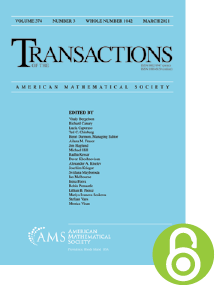The Jantzen sum formula for cyclotomic $q$–Schur algebras
HTML articles powered by AMS MathViewer
- by Gordon James and Andrew Mathas PDF
- Trans. Amer. Math. Soc. 352 (2000), 5381-5404 Request permission
Abstract:
The cyclotomic $q$-Schur algebra was introduced by Dipper, James and Mathas, in order to provide a new tool for studying the Ariki-Koike algebra. We here prove an analogue of Jantzen’s sum formula for the cyclotomic $q$-Schur algebra. Among the applications is a criterion for certain Specht modules of the Ariki-Koike algebras to be irreducible.References
- W. J. Trjitzinsky, General theory of singular integral equations with real kernels, Trans. Amer. Math. Soc. 46 (1939), 202–279. MR 92, DOI 10.1090/S0002-9947-1939-0000092-6
- Susumu Ariki, On the semi-simplicity of the Hecke algebra of $(\textbf {Z}/r\textbf {Z})\wr {\mathfrak {S}}_n$, J. Algebra 169 (1994), no. 1, 216–225. MR 1296590, DOI 10.1006/jabr.1994.1280
- Susumu Ariki and Kazuhiko Koike, A Hecke algebra of $(\textbf {Z}/r\textbf {Z})\wr {\mathfrak {S}}_n$ and construction of its irreducible representations, Adv. Math. 106 (1994), no. 2, 216–243. MR 1279219, DOI 10.1006/aima.1994.1057
- Richard Dipper and Gordon James, Blocks and idempotents of Hecke algebras of general linear groups, Proc. London Math. Soc. (3) 54 (1987), no. 1, 57–82. MR 872250, DOI 10.1112/plms/s3-54.1.57
- Richard Dipper and Gordon James, The $q$-Schur algebra, Proc. London Math. Soc. (3) 59 (1989), no. 1, 23–50. MR 997250, DOI 10.1112/plms/s3-59.1.23
- R. Dipper, G. James, and A. Mathas, Cyclotomic $q$–Schur algebras, Math. Z., 229 (1998), 385–416.
- Richard Dipper, Gordon James, and Eugene Murphy, Gram determinants of type $B_n$, J. Algebra 189 (1997), no. 2, 481–505. MR 1438185, DOI 10.1006/jabr.1996.6841
- J. J. Graham and G. I. Lehrer, Cellular algebras, Invent. Math. 123 (1996), no. 1, 1–34. MR 1376244, DOI 10.1007/BF01232365
- James A. Green, Polynomial representations of $\textrm {GL}_{n}$, Lecture Notes in Mathematics, vol. 830, Springer-Verlag, Berlin-New York, 1980. MR 606556, DOI 10.1007/BFb0092296
- G. D. James, The representation theory of the symmetric groups, Lecture Notes in Mathematics, vol. 682, Springer, Berlin, 1978. MR 513828, DOI 10.1007/BFb0067708
- Gordon James and Adalbert Kerber, The representation theory of the symmetric group, Encyclopedia of Mathematics and its Applications, vol. 16, Addison-Wesley Publishing Co., Reading, Mass., 1981. With a foreword by P. M. Cohn; With an introduction by Gilbert de B. Robinson. MR 644144
- G. D. James and A. Mathas, The irreducible Specht modules in characteristic $2$, Bull. London Math. Soc. 31 (1999), 457–462.
- Gordon James and Andrew Mathas, A $q$-analogue of the Jantzen-Schaper theorem, Proc. London Math. Soc. (3) 74 (1997), no. 2, 241–274. MR 1425323, DOI 10.1112/S0024611597000099
- Jens C. Jantzen, Kontravariante Formen auf induzierten Darstellungen halbeinfacher Lie-Algebren, Math. Ann. 226 (1977), no. 1, 53–65. MR 439902, DOI 10.1007/BF01391218
- A. Mathas, Hecke algebras and Schur algebras of the symmetric group, Univ. Lecture Notes, 15, A.M.S., Providence, R.I., 1999.
- G. E. Murphy, A new construction of Young’s seminormal representation of the symmetric groups, J. Algebra 69 (1981), no. 2, 287–297. MR 617079, DOI 10.1016/0021-8693(81)90205-2
- G. E. Murphy, On the representation theory of the symmetric groups and associated Hecke algebras, J. Algebra 152 (1992), no. 2, 492–513. MR 1194316, DOI 10.1016/0021-8693(92)90045-N
Additional Information
- Gordon James
- Affiliation: Department of Mathematics, Imperial College, Queen’s Gate, London SW7 2BZ, United Kingdom
- Email: g.james@ic.ac.uk
- Andrew Mathas
- Affiliation: School of Mathematics, University of Sydney, Sydney NSW 2006, Australia
- MR Author ID: 349260
- Email: a.mathas@maths.usyd.edu.au
- Received by editor(s): March 18, 1998
- Received by editor(s) in revised form: December 1, 1998
- Published electronically: June 14, 2000
- Additional Notes: The authors would like to thank the Isaac Newton Institute for its hospitality. The second author also gratefully acknowledges the support of the Sonderforschungsbereich 343 at the Universität Bielefeld.
- © Copyright 2000 American Mathematical Society
- Journal: Trans. Amer. Math. Soc. 352 (2000), 5381-5404
- MSC (2000): Primary 16G99; Secondary 20C20, 20G05
- DOI: https://doi.org/10.1090/S0002-9947-00-02492-2
- MathSciNet review: 1665333


